
Patmos / Πάτμος
The Monastery of John the Theologian and the Hora
I had made sure to visit the Cave of the Apocalypse
my first morning on Patmos.
The next day I would go to the peak and visit the
Monastery of John the Theologian,
which was founded in 1088.
Patmos is one of the few places where religious ceremonies
dating back to early Christian times are still practiced
with very little change.
The monastic community preserves and practices
early Byzantine traditions and rituals.
I would also explore Hora,
the walled town surrounding it.
This is the only example in Greece of a fortified
monastery surrounded by a secular settlement.
My innkeeper at Villa Zacharo had a useful collection of bus and ferry schedules. I would take the bus for the 200-meter ascent up the hill, visit the monastery and explore the town, and then walk back downhill. 07:50 is a little early for me, I'll take the 09:25 bus.
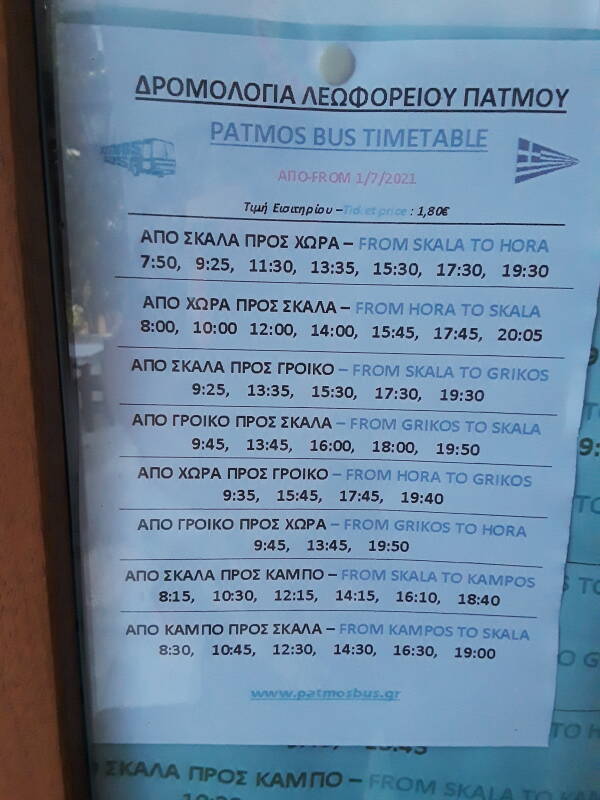
Patmos in John's Time
The island was first settled in the Middle Bronze Age around 2,000 BCE. Later it was settled by people from the Asian mainland, worshipers of Artemis. They built a Temple of Artemis on this high point. By the third century BCE their hilltop settlement had become an acropolis with a surrounding fortification wall and watch towers.
A large church was built over the ruins of the Temple of Artemis in the 4th century CE. That Temple of Artemis had still been in operation when John was there, dominating the skyline then in the way that the Monastery of John the Theologian does today.
Reading the Apocalypse on the Island of PatmosIan Boxall's paper Reading the Apocalypse on the Island of Patmos discusses what we know and what we can at least speculate about regarding Patmos at that time. There weren't many references to Patmos in classical works. Thucydides' History of the Peloponnesian War (3.33:3) simply mentions Patmos in passing. Strabo's Geography (10.5.13) and Pliny the Elder's Natural History (4.12.69) listed islands in the area and their relative positions, including Patmos. Revelation only mentions Patmos once (1:9), "I, John, your brother who shares with you in the hardship, kingdom, and endurance that we have in Jesus, was on the island called Patmos because of the word of God and my witness about Jesus."
There has been very little archaeological work on Patmos. What has been done shows that the peak of the island had been inhabited since the Middle Bronze Age, with fortifications built in the Hellenistic Age. It was a large enough settlement to have its own gymnasium. And, the cult of the goddess Artemis was strong. Her temple at the peak would have dominated skyline when John was here, just as the monastery does today.
The local cult said that this was her birthplace, competing with the islands of Delos and Nasos plus Ephesus on the mainland. Patmos was a district of the important sea port of Miletos on the mainland. That strengthened the link with Artemis and also her brother Apollo and her mother Leto. Ten miles to the south of Miletos was Didymas with its shrine and oracle of Apollo. By the first century Didymas was a rival to the more famous Oracle of Delphi. Its high priest was called "the Prophet". This meant that Apollo was the god of prophecy in the local world view on Patmos. The fifth century text Acts of the Holy Apostle and Evangelist John the Theologian by his disciple Prochorus, found in the library of this monastery, refers frequently to a temple of Apollo on Patmos, likely at the peak.
Amazon
ASIN: B00YFPWAOA
So while John doesn't refer to Artemis and Apollo by name in Revelation, they were part of a rival symbolic world. For example, some scholars have said that the bow-carrying Rider on the White Horse in Revelation 6 is an Apollo figure. To someone living in Miletos or its island territories in the first century, a figure carrying a bow would obviously reference Apollo.
Other scholars have written that the woman and the dragon of Revelation 12 are a subversion of the ancient Near Eastern "combat myth", intentionally referencing the pregnant Leto, the dragon Python, and the birth of Apollo.
John the prophet of the true God wanted his audience to imagine a world very different from that described by the local false prophets.
MormonCosmology
Meanwhile the Church of Jesus Christ of Latter-Day Saints teaches that John did not die but has wandered the earth ever since. And, in 1829, along with the resurrected Peter and James, the three of them visited Joseph Smith and Oliver Cowdery and set them up as authorities of the Apostolic succession on earth. And also that you can become a god and get your own planet to rule over. Really.
Founding the Monastery
In 1088 the Byzantine Emperor Alexios I Komnenos gave Father Ioannis Christodoulos of Asia Minor complete authority over the island of Patmos, along with permission to build a monastery there. This was part of Komnenos' plan to colonize the islands and build up the Byzantine presence in the Aegean.
It took until 1101 for construction to start. By now the 4th century church was in ruins, so they began building the monastery there. It was the frequent pattern of a series of religious facilities built in the same place. Sometimes to emphasize the point that a new faith was replacing an older one, like the 4th century church built on the ruins of the temple of Artemis. Sometimes simply because the location was auspicious.
One tradition says that an early Christian church had replaced the Temple of Artemis in the fourth century. But another says that the temple was still visible in the early eleventh century, and Christodoulos destroyed its great cult statue.
The monastery became the main controlling force on the island, and the town grew up around it. Here's the view from the monastery down over Skala and the port, where a ferry is arriving.
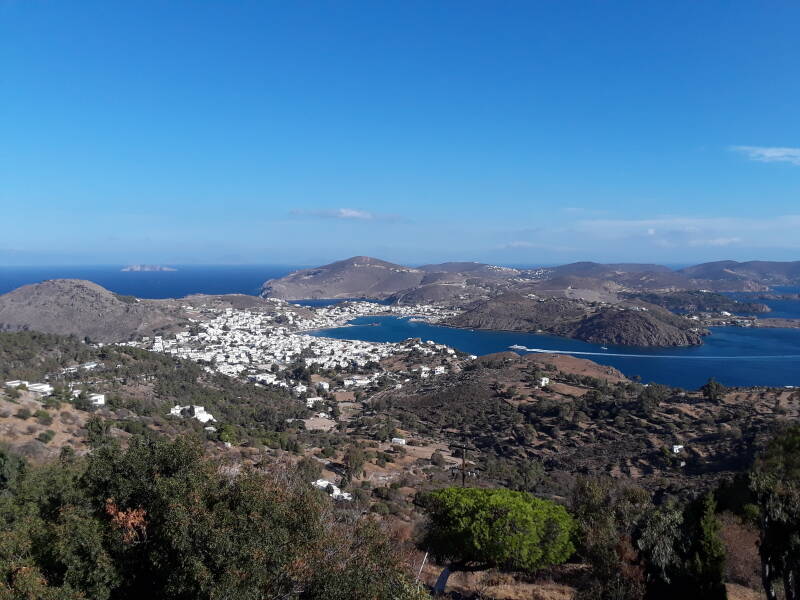
There were interruptions caused by piracy and raids by the forces of the Emir of Smyrna, today's İzmir. Construction restarted in 1095, by which point the Abbot Christodoulos had died. They buried him in the narthex.
By the late 1100s the western Europeans were attacking. The Normans attacked in 1186, and the Franks in 1192. But the fortifications held.
Entering the Monastery
The bus lets you off at the edge of the settlement. I have walked up some narrow passageways and a few sets of stairs to reach the entry to the fortified monastery.
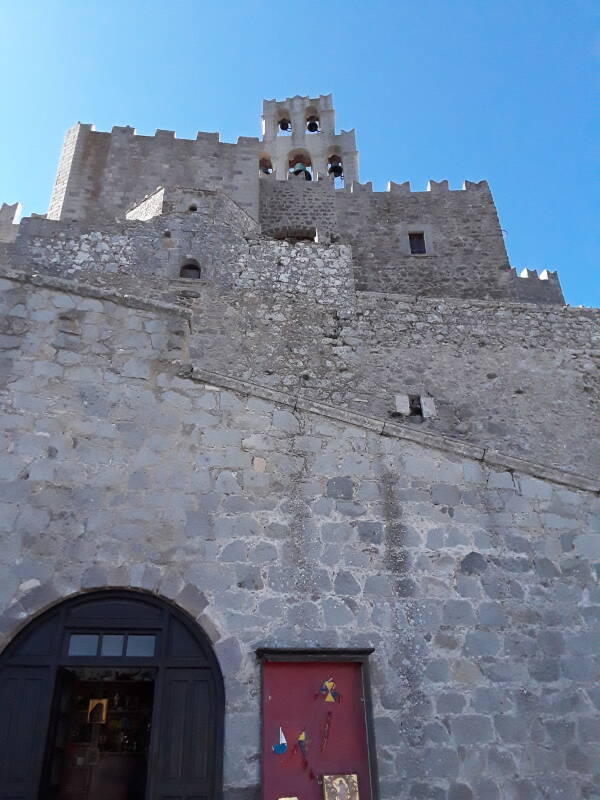
The monastery has a significant collection of manuscripts including 82 early manuscripts of the New Testament, many dated to the sixth to ninth centuries CE. It soon became, and continues to be, a destination for pilgrimage and a base of Greek Orthodox learning.
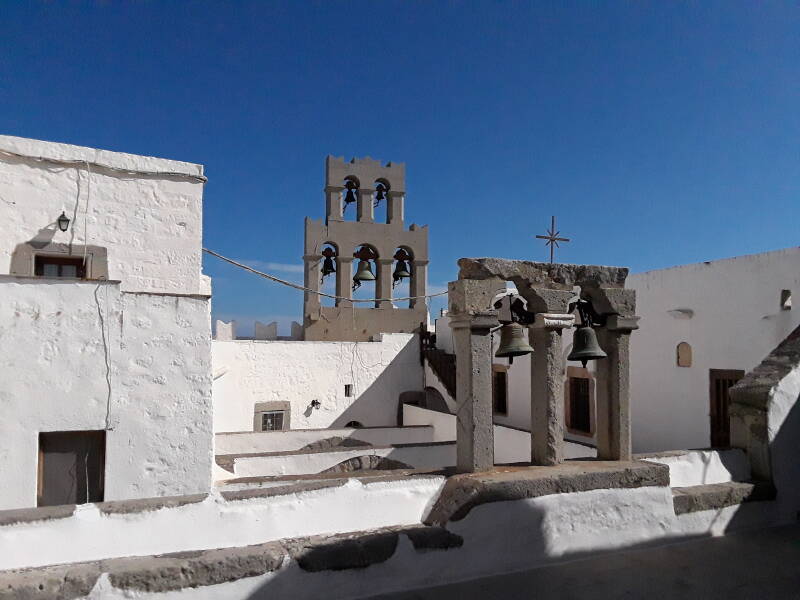
The earliest elements of the monastery, dating to the initial construction of the late 11th century, are the Καθολικόν or Katholikón, the main church; the Chapel of Παναγία, Panagia or All-Holy, dedicated to Mary; and the refectory. The south side of the courtyard is the Tzafara, a two-story arcade built from dressed stone in 1698.
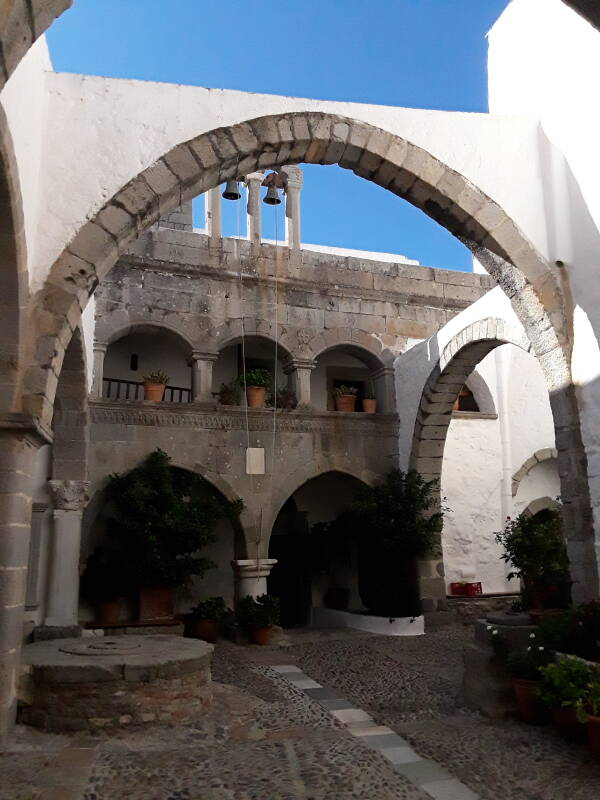
The outer narthex of the Katholikón forms the east side of the courtyard. A narthex is sort of a front porch or lobby area of a church, at the opposite end from the altar.
The north and west sides of the courtyard are lined with monastic cells with white walls. Below you see the outer narthex of the Katholikón.
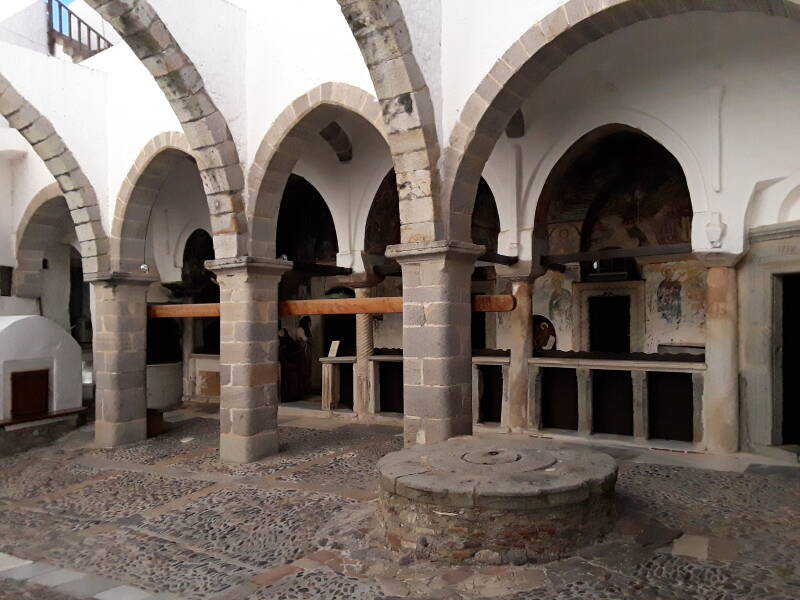
The inner surfaces of the Katholikón are covered with frescoes dating to 1600.
The narthex, where photography is tolerated, is similarly decorated.
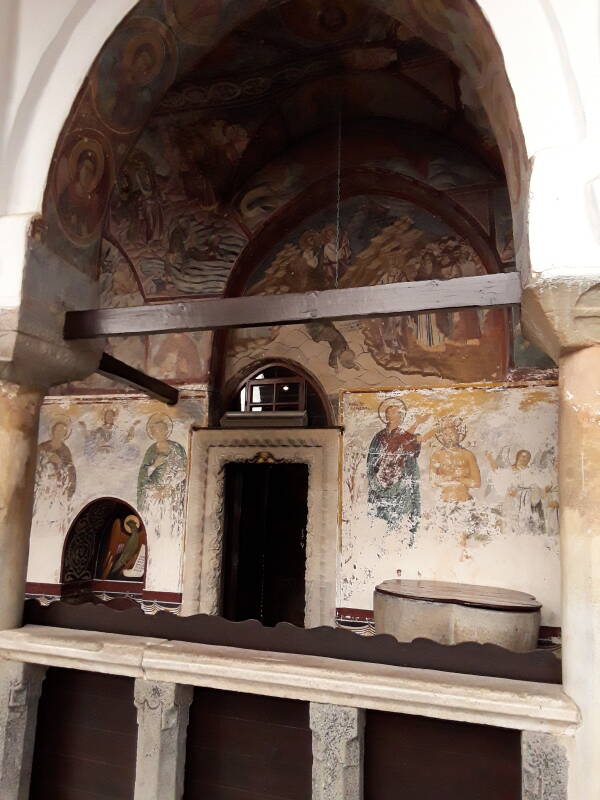
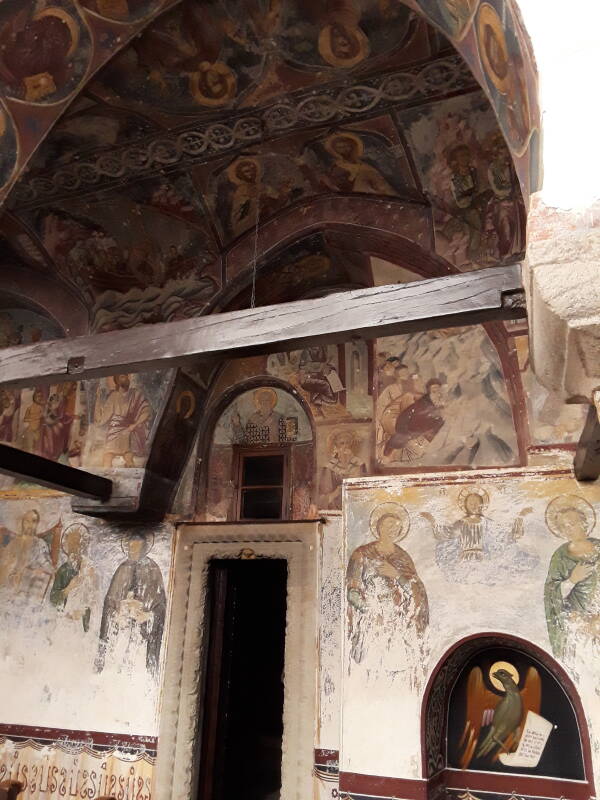

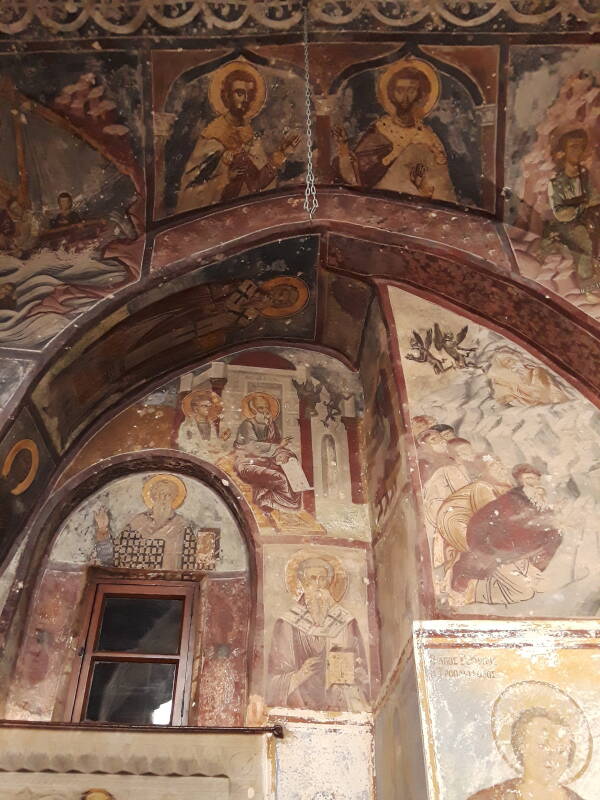
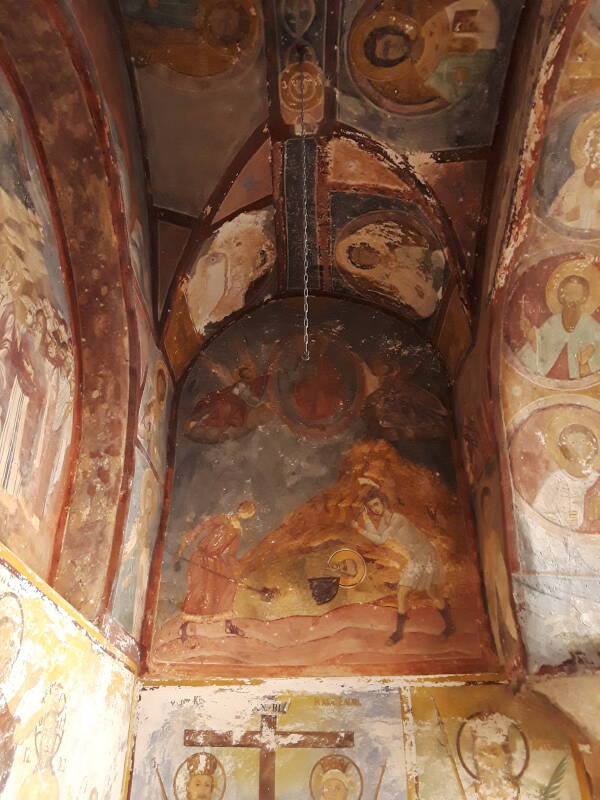
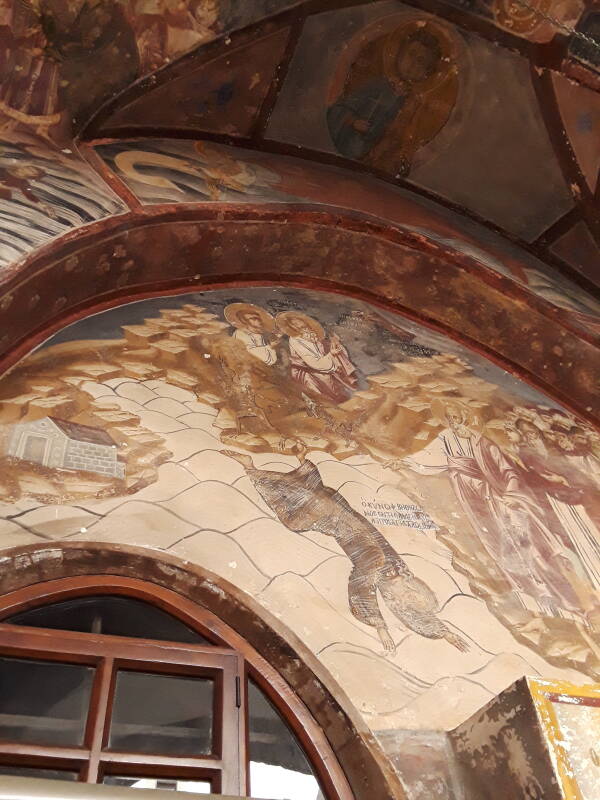
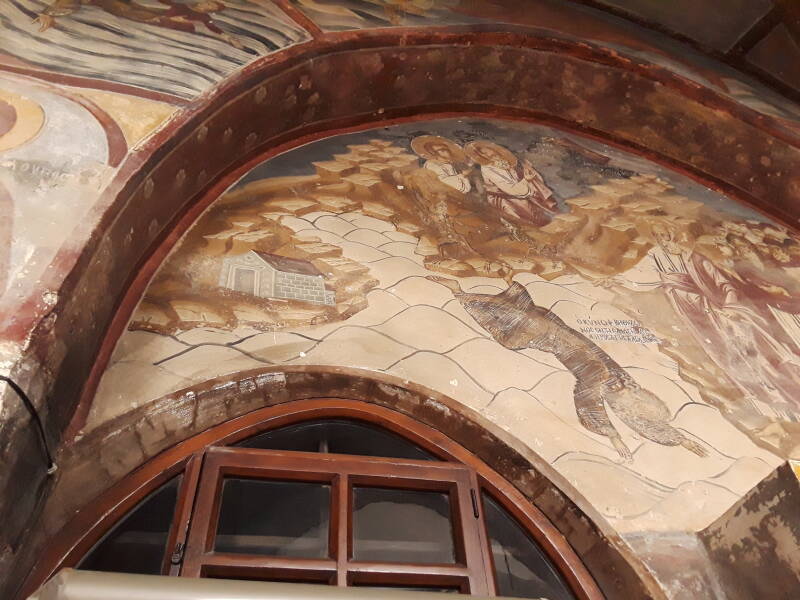
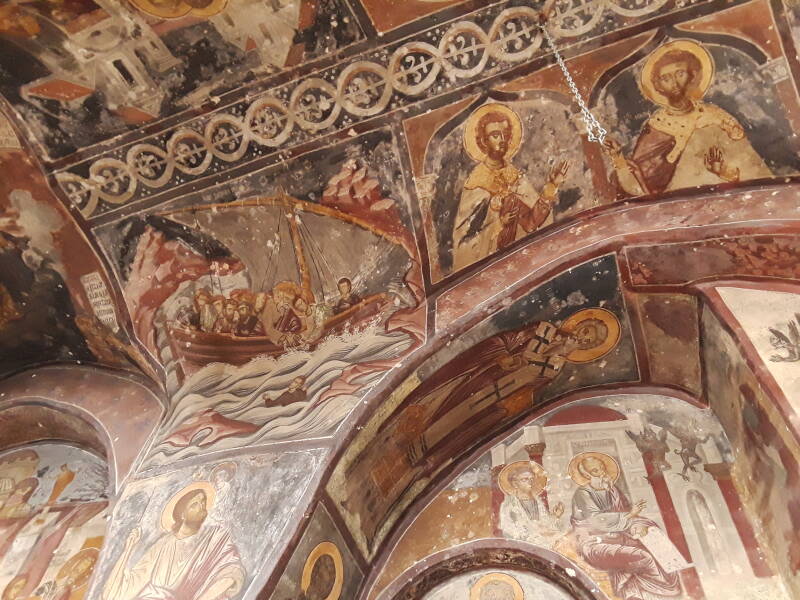
The museum within the monastery is fantastic. The library is one of the few monastic libraries that have survived to today without most of its collection being destroyed.
Also, although it was established after the Schism of 1054 when the bishops of Rome and Constantinople mutually excommunicated each other and split Christianity in two, the library still contains material from before the Schism.
Hora
The surrounding settlement had been kept small, according to the wishes of Christodoulos. But the population swelled after 1453 when the Ottoman Turks led by Sultan Mehmed II, "The Conqueror", captured Constantinople. About "a hundred" refugee families from Constantinople settled here, creating the neighborhood of Alótina to the west of the monastery.
That was a relatively large group of people from the sophisticated capital city of Constantinople, arriving in a small community of tenant farmers. That made for a sudden and large change to the community, bringing a drastic change in the local architecture.
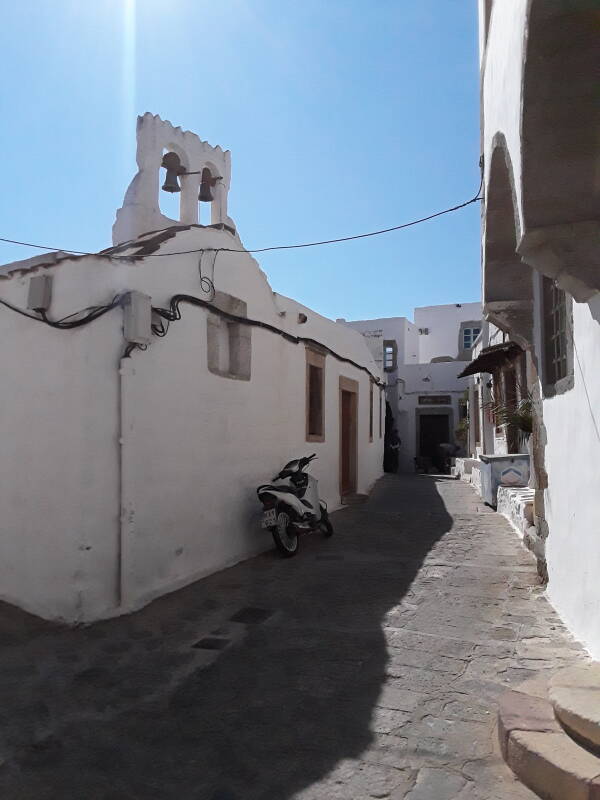
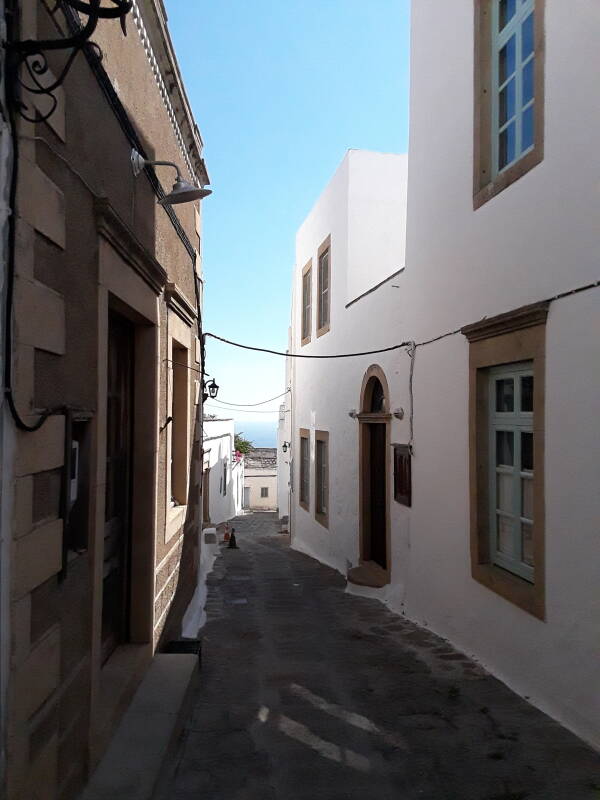
The Hora is one of the oldest and best preserved in the Aegean. Patmos was a thriving trading center during the time of Ottoman control. The Turks were always quite tolerant of other faiths, and quite interested in trade. There are several fine merchants' houses from the 16th and 17th centuries. From several of them the merchants could look down over their ships and warehouses in the port.
Then there was another population surge in 1669 when the Venetians captured Candia on Crete and about fifty more families arrived from there.
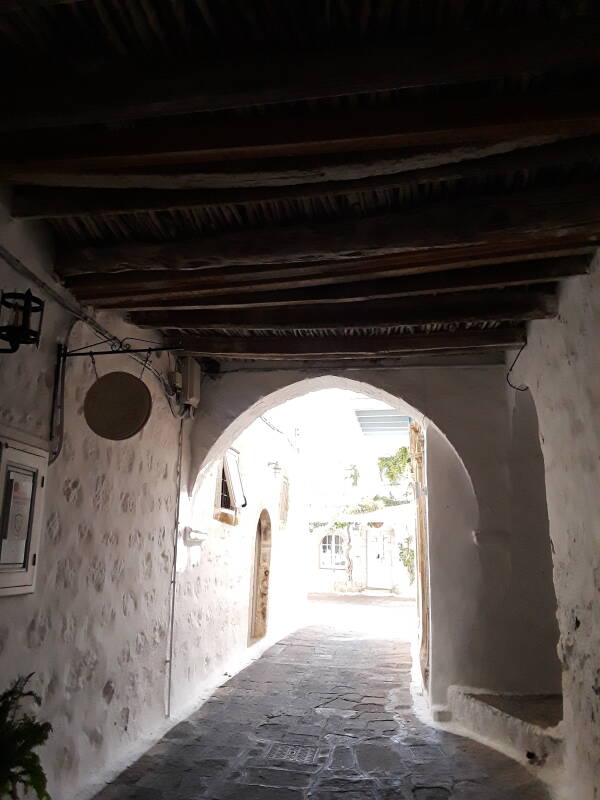
The early mansions were large, set in their own gardens. As the population grew, the gaps between the original mansions were filled with smaller homes. The Hora became an increasingly packed collection of structures with tiny lanes between them.
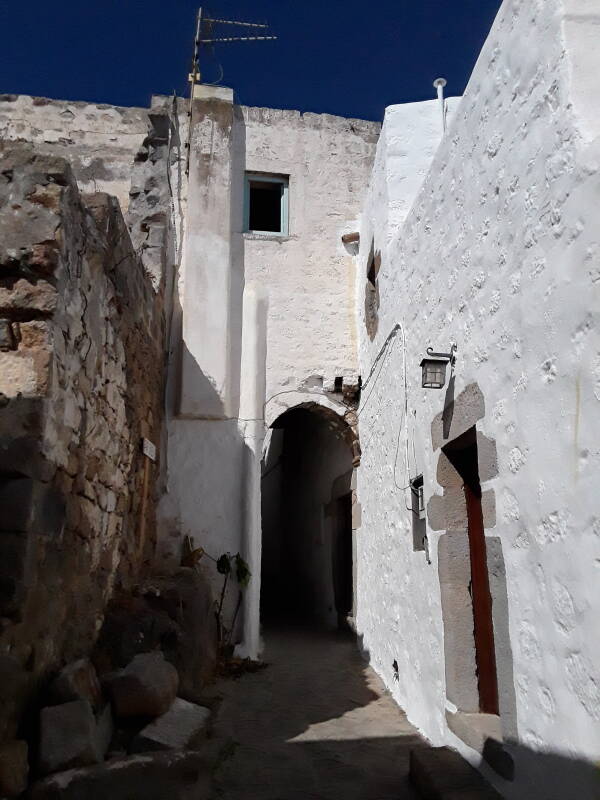
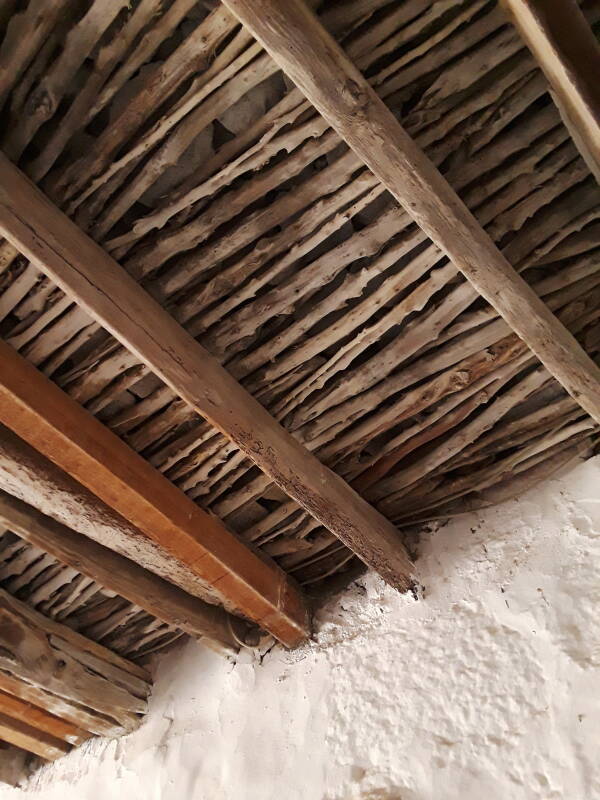
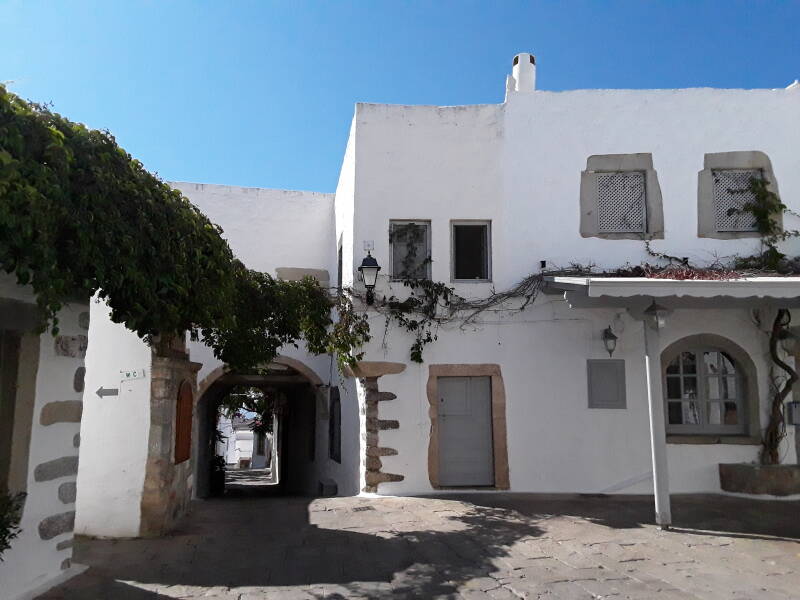
A common thread to the architecture was the dressed stone corners of the houses and the elaborately carved door and window frames, with white plaster over the main surfaces of the walls.
The roofs were flat to catch rainwater and channel it to underground cisterns.
Some larger homes retained an avli or walled courtyard, either at ground level or one the roof.
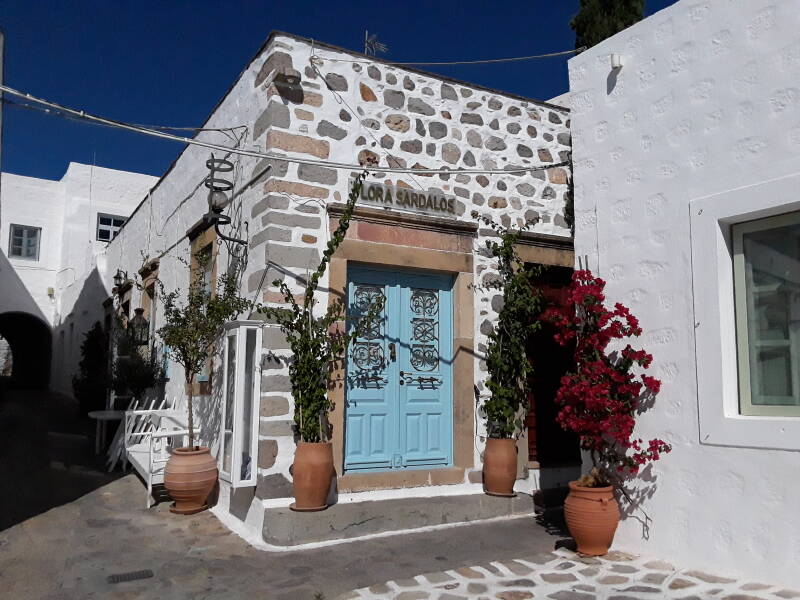
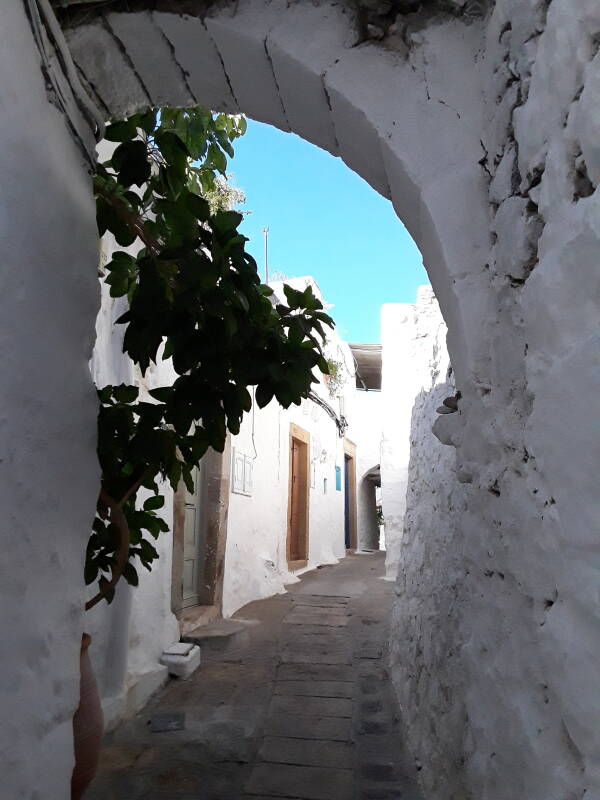
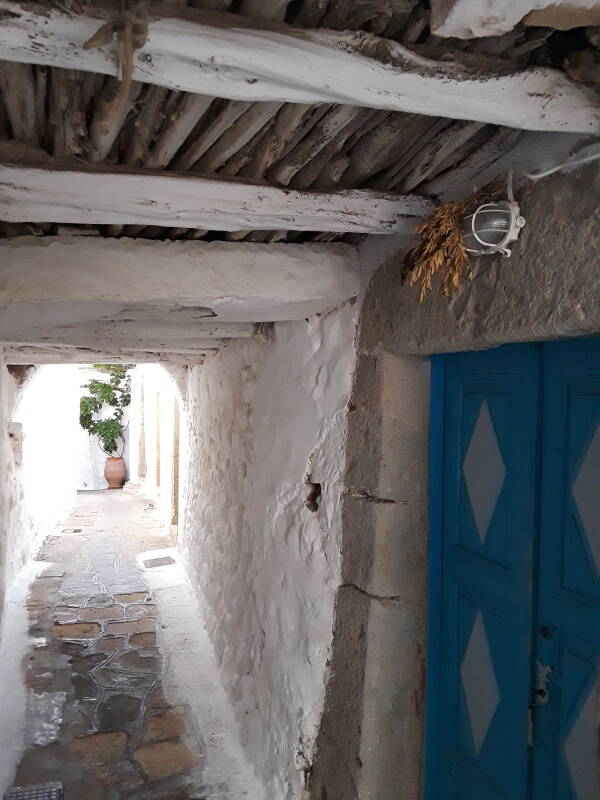
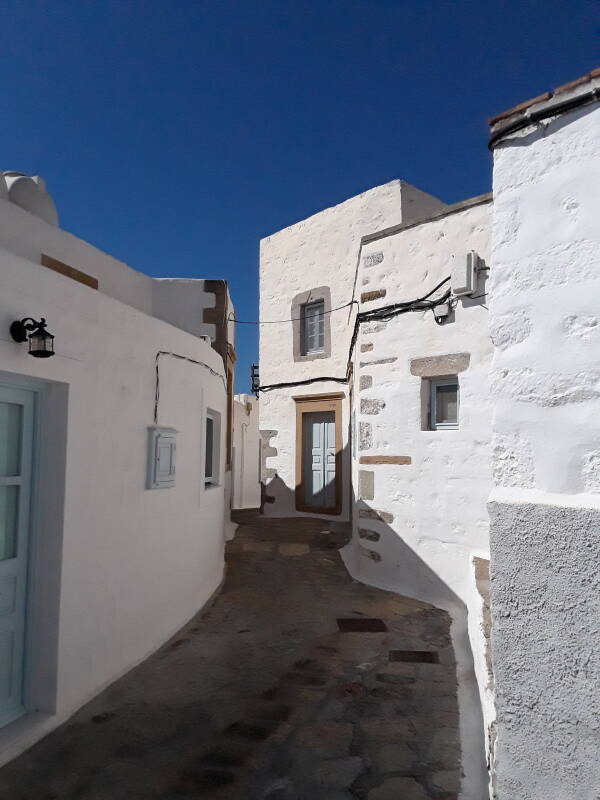
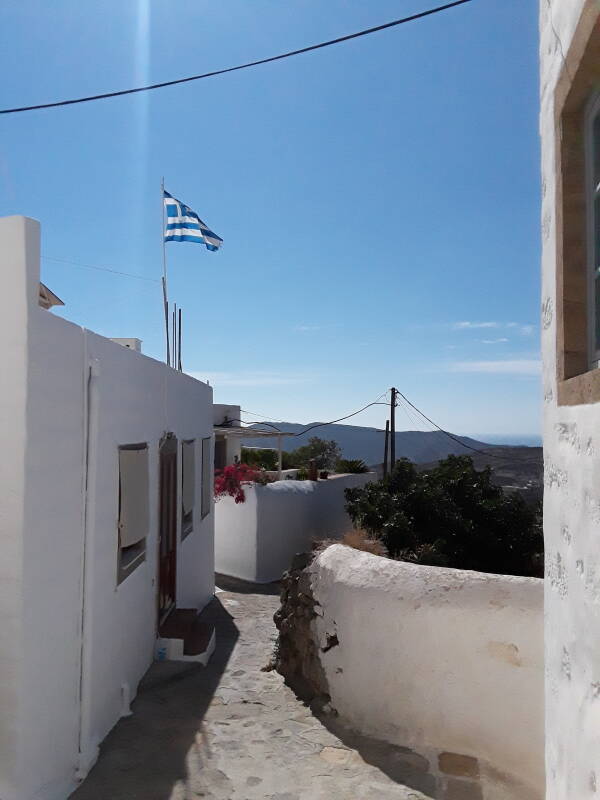
The merchants of Hora built several small churches with fine icons and mural paintings.

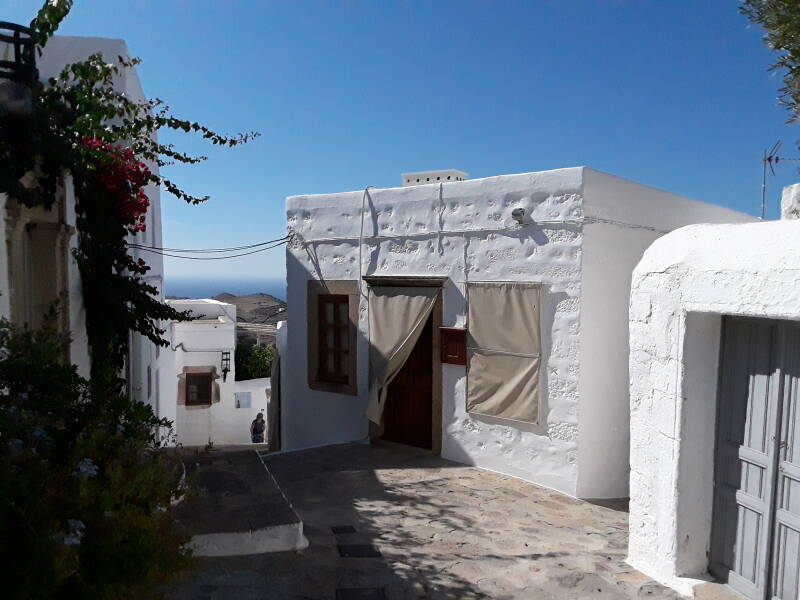
There are churches or chapels everywhere. The difference, usually, is that a church has a priest specifically assigned to it with one or more regularly scheduled services every week, while a free-standing chapel does not. That's usually the difference, as I understand it. Of course a large church might contain small chapels within it.
Then a cathedral is the base for a bishop. It's often called "the seat of the bishop", as it's made a cathedral by housing the bishop's throne, a special chair which is really the thing called the cathedral. In Roman Catholicism, a bishop might sit in that throne to make a special pronouncement, speaking ex cathedra, Latin for "from the cathedral". That led to the concept of the position of a university professor being "a chair".
The doctrine of papal infallibility is actually recent. Pope Pius IX sat in the cathedral chair in Saint Peter's in the Vatican in 1870 and announced that everything said by the Pope while sitting in that chair was infallible truth, because he was sitting in that chair while he said so, and therefore it must be the truth that what he said was the truth, about everything said there being the truth, and so on. Recursion. Or maybe just circularity.
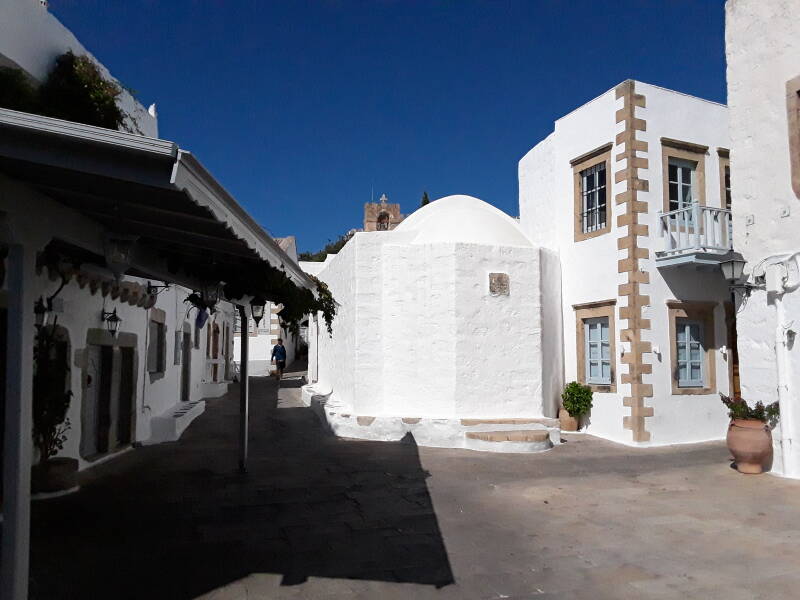
Here's the view to the north that some of those merchants would have had from the upper floors of their homes, looking down over Skala and the port. You can see how Patmos is almost two islands, with a narrow isthmus joining the two main sections.
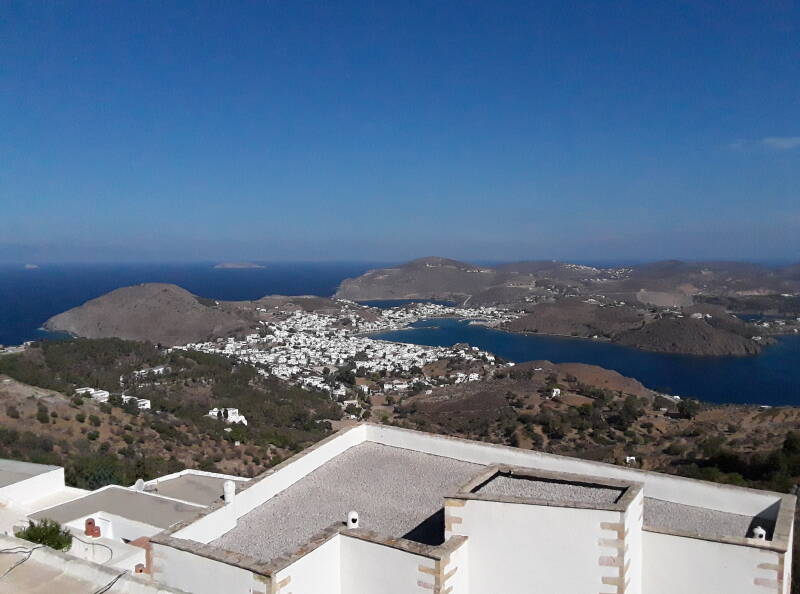
Looking to the east, out the opening of the harbor, Λειψοί or Lipsi is visible about 15 kilometers away on the horizon to the right. Less obvious, on the horizon at center, are the peaks on Σάμος or Samos, the last island on the way to Ephesus. On a clear day, with less haze than you see here, you can see the Turkish coast. All this would be a constant reminder to John of his separation from those seven churches of Asia Minor to whom he was directing his message.
Some old windmills line the ridge, catching the strong Aegean winds.
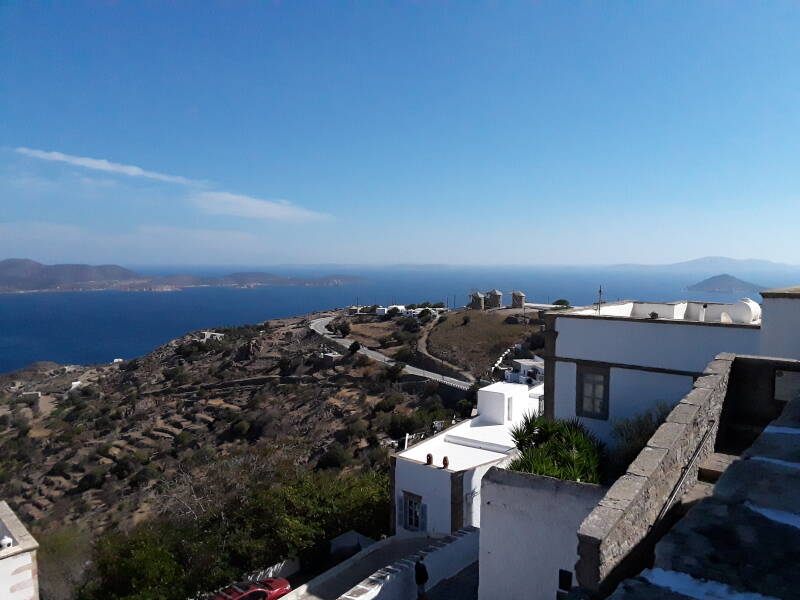
I have descended through Hora to the highest point of the main road, ready to head back down to Skala.
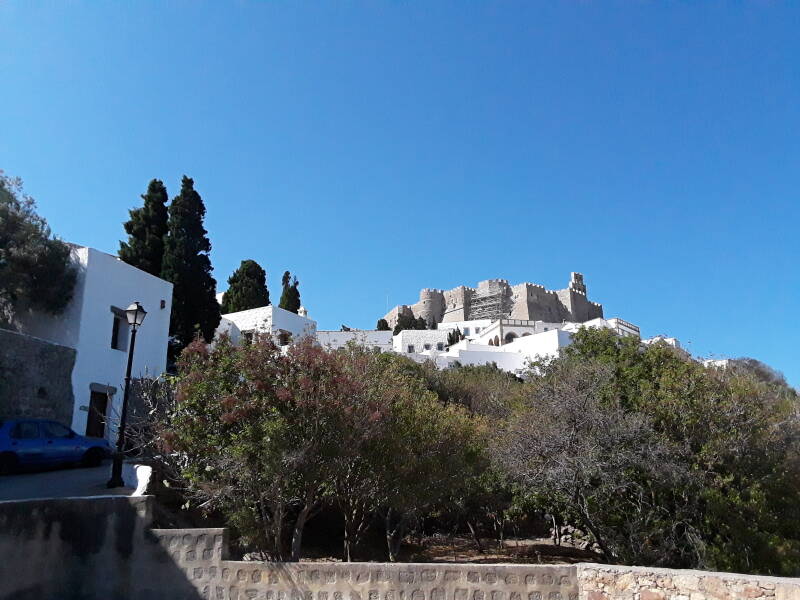
Returning to Skala
I'm walking back down to Skala, passing where the footpath joins the road. I'll stay on the road.
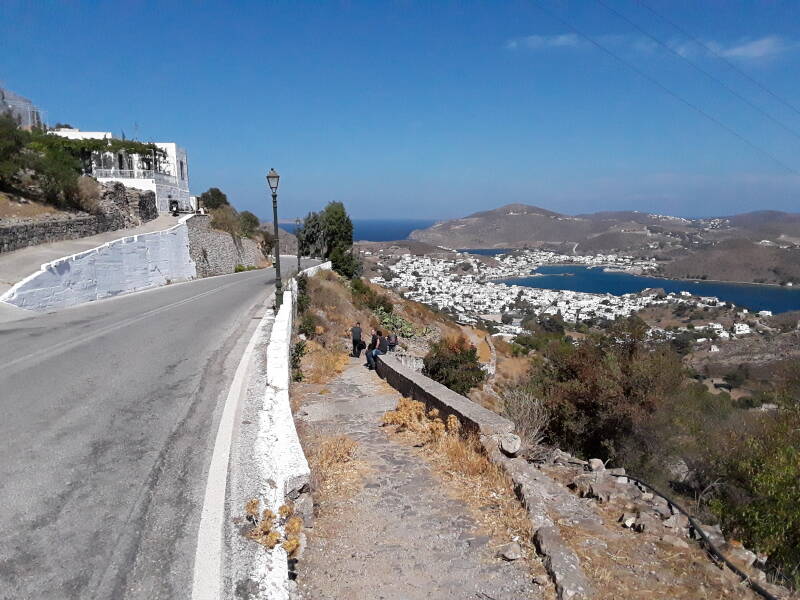
Here's a small chapel along the road. I'll go in and look at its icons.
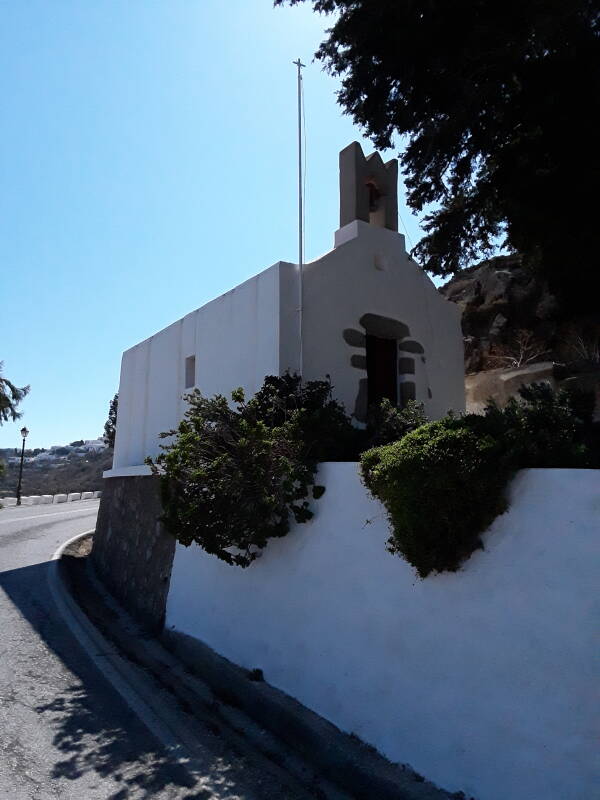
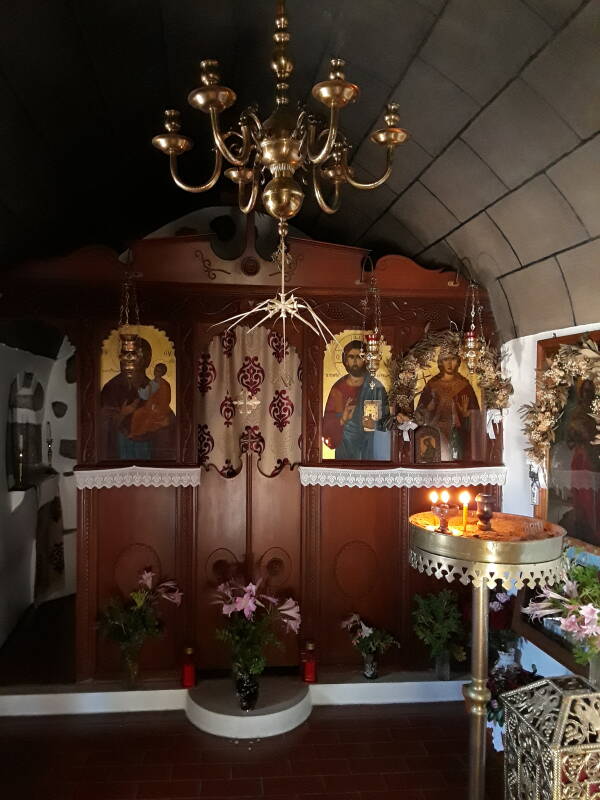
Back down in Skala I see a priest with his scooter.
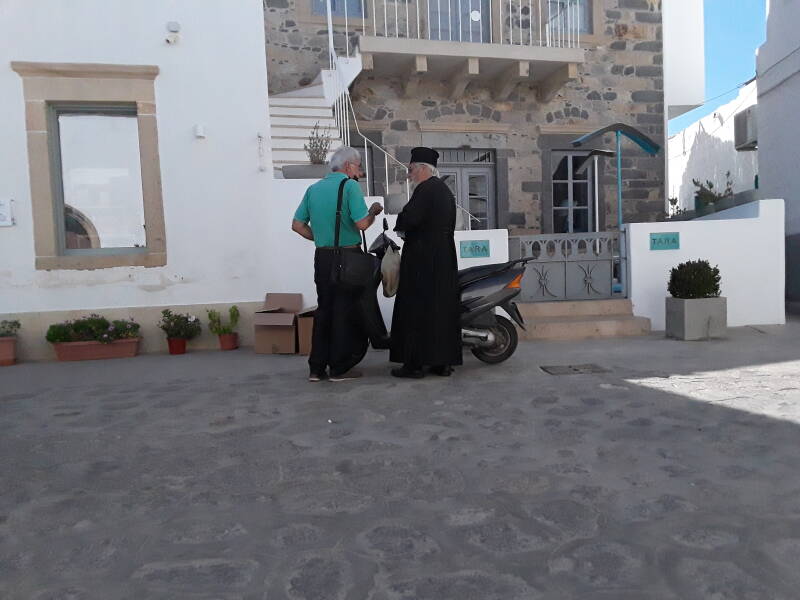
Now it's time to relax in Skala.
Or, Continue Through Greece: